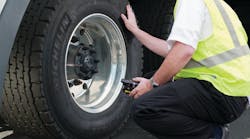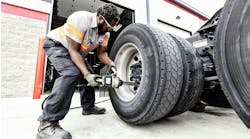Tire maintenance can have a major impact on the cost of operations for a fleet. The overall goal of any fleet should focus on maintaining all tires at the fleet target inflation pressure based on the manufacturer's application data book for the particular axle load. When monitoring inflation pressure, well-maintained fleets keep the tires within 5 psi of this setting, and not more than 5 psi different than the dual tire next to it in operation.
To ensure safety and efficiency, fleets should consider the following six major areas when optimizing tire maintenance.
- Low inflation pressure
Under-inflation is the biggest issue in the commercial vehicle industry. It is the number one cause of premature tire removal. With the advancement in today’s radial casing, it is virtually impossible to determine if a tire is properly inflated without using a pressure gauge. Periodically calibrate the gauges using a master gauge. Over time, usage conditions can cause a pressure gauge to lose accuracy beyond the 2 psi manufacturer’s tolerance range. The time and effort required to verify gauges and to check tire pressure is time well spent.
Effect: An inflation pressure mismatch of greater than 5 psi will result in the two tires of a dual assembly being significantly different in circumference, resulting in irregular wear. This mismatch can also lead to eventual tire loss due to premature casing fatigue. A difference of 5 psi between steer tires will cause the vehicle to pull to the side with the lower pressure. Additionally, under-inflation results in internal tire heat buildup and potential premature tire failure.
Goal: Maintain all tires at the fleet target inflation pressure based on the manufacturer's application data book for the particular axle load.
2. High inflation pressure
Over-inflated tires increase the likelihood of crown cuts, impact breaks, punctures and shock damage resulting from the decrease of sidewall flexing and an increase in firmness of the tread surface.
Effect: Over-inflation can increase the probability of potential casing damage. This change in contact patch footprint could result in a reduction of traction and tread life.
Goal: Maintain all tires at the fleet target inflation pressure based on the manufacturer's application data book for the particular axle load.
3. Missing valve caps
Missing valve caps are a primary source of low inflation pressure. Valve caps are used to keep debris out of the core and act as a secondary air seal if the valve core happens to leak. Verify there is a tight seal by using a spray-type leak detector. A good metal cap with a rubber seal will hold tire pressure without a valve core.
Effect: The number one cause of tire pressure loss can be attributed to missing valve caps. Operating without valve caps can result in under-inflation and the conditions mentioned above.
Goal: Install suitable valve caps on all wheel positions. Consider the use of inflate-through valve caps for easier pressure maintenance.
4. Dual mismatch inflation pressure
Dual mismatched pressures can cause a permanent irregular wear patterns to develop. Within a few weeks, this irregular wear can potentially be a cause of early tire removal. Dual mismatched pressure will also impact the matched tire, causing accelerated tread wear and casing fatigue.
Effect: This irregular wear can result in early removal or require tire rotation to minimize the effect.
Goal: Maintain all tires at the fleet target inflation pressure based on the manufacturer's application data book for the particular axle load. Well-maintained fleets keep the tires within 5 psi of this setting when monitoring inflation pressure.
5. Dual mismatch height
Dual mismatch tread depths (tire height differences) will cause irregular wear. Additionally, the larger tire (the one with the greatest tread depth) will become over-fatigued due to bearing more weight. This accelerates premature casing failure.
Effect: Dual mismatch tread depths can cause a permanent irregular wear pattern in a few weeks, resulting in early removal or a lost casing.
Goal: Match tires in dual assembly with equal tread depths. Well maintained fleets use +/- 4/32" of tread depth as the maximum allowable difference in overall height between the duals.
6. Irregular wear
Proper inflation pressure, correct toe settings and proper alignment can prevent most irregular wear. Steer, drive and trailer axle alignment verification and correction can be performed with a minimal cost or investment in equipment.
Effect: Once a wear pattern develops, it will continue until the tire is rotated or removed to be retreaded or scrapped. Diagnosis and correction of the cause is part of the solution in preventing future conditions. Average occurrence of irregular wear typically results in a loss of tread life, resulting in a much higher total cost of ownership.
Goal: Reduce irregular wear by following proactive tire and vehicle maintenance programs.
Paul Tatarchuk is special services coordinator for the Michelin Heavy Truck Tire Customer Engineering Support Group. Tatarchuk has worked for Michelin for more than 13 years. Starting in passenger car OEM tire project management, he moved to Michelin’s headquarters in Greenville, South Carolina in 2015.



